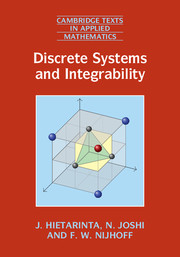Book contents
- Frontmatter
- Dedication
- Contents
- Preface
- 1 Introduction to difference equations
- 2 Discrete equations from transformations of continuous equations
- 3 Integrability of P∆Es
- 4 Interlude: Lattice equations and numerical algorithms
- 5 Continuum limits of lattice P∆E
- 6 One-dimensional lattices and maps
- 7 Identifying integrable difference equations
- 8 Hirota's bilinear method
- 9 Multi-soliton solutions and the Cauchy matrix scheme
- 10 Similarity reductions of integrable P∆Es
- 11 Discrete Painlevé equations
- 12 Lagrangian multiform theory
- Appendix A Elementary difference calculus and difference equations
- Appendix B Theta functions and elliptic functions
- Appendix C The continuous Painlevé equations and the Garnier system
- Appendix D Some determinantal identities
- References
- Index
11 - Discrete Painlevé equations
Published online by Cambridge University Press: 05 September 2016
- Frontmatter
- Dedication
- Contents
- Preface
- 1 Introduction to difference equations
- 2 Discrete equations from transformations of continuous equations
- 3 Integrability of P∆Es
- 4 Interlude: Lattice equations and numerical algorithms
- 5 Continuum limits of lattice P∆E
- 6 One-dimensional lattices and maps
- 7 Identifying integrable difference equations
- 8 Hirota's bilinear method
- 9 Multi-soliton solutions and the Cauchy matrix scheme
- 10 Similarity reductions of integrable P∆Es
- 11 Discrete Painlevé equations
- 12 Lagrangian multiform theory
- Appendix A Elementary difference calculus and difference equations
- Appendix B Theta functions and elliptic functions
- Appendix C The continuous Painlevé equations and the Garnier system
- Appendix D Some determinantal identities
- References
- Index
Summary
In earlier chapters we explained how to derive discrete Painlevé equations through different perspectives, relying on symmetries, deautonomization through singularities, and geometry. Discrete Painlevé equations were found as recurrence relations of the Painlevé equations in Section 2.3 of Chapter 2, identified through the singularity confinement property in Section 7.1, found as similarity reductions of lattice equations in Chapter 10, and described through a unifying geometric point of view (Sakai, 2001) as mappings on rational surfaces in Section 7.3 in Chapter 7.
Discrete Painlevé equations arise in various mathematical and physical contexts, for example in random matrix theory, in models of quantum gravity, and as correlation functions in statistical mechanics. They also appear as nonlinear equations satisfied by coefficients of linear three-term recurrences governing orthogonal polynomials with semiclassical weights. They are pushing the boundary of what we define to be nonlinear special functions because they are regarded as defining equations for an entirely new class of special functions.
The focus of this chapter lies on the intrinsic properties of discrete Painlevé equations as integrable systems. After starting with a brief history of their discovery, we describe and deduce transformations between solutions, such as Bäcklund or Miura transformations. Then we focus on their associated linear problems and describe the different types that arise. The theory developed by Birkhoff and his school for solving linear difference equations is outlined and we suggest ways in which compatible linear problems could be used to solve nonlinear discrete Painlevé equations. Finally, we describe special solutions of the discrete Painlevé equations along with methods developed for deducing such solutions.
In the literature, there are three different types of discrete Painlevé equations, distinguished by the curves along which they are iterated, i.e. a straight line, a spiral or an elliptic curve in the complex plane, leading to what are respectively called additive-type, multiplicative-type or elliptic-type discrete Painlevé equations. If the equation is iterated by a shift in the independent variable n, say, then these cases are distinguished by the types of coefficient functions z(n) appearing in the equation.
- Type
- Chapter
- Information
- Discrete Systems and Integrability , pp. 304 - 333Publisher: Cambridge University PressPrint publication year: 2016

